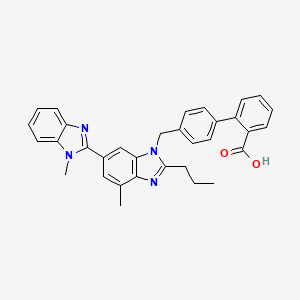Hypertension
Adult: Initially, 40 mg once daily, may be adjusted to 20-80 mg once daily according to clinical response. Max: 80 mg once daily.
Oral
Cardiovascular risk reduction
Adult: 80 mg once daily.
|
Indications and Dosage
Oral
Hypertension Adult: Initially, 40 mg once daily, may be adjusted to 20-80 mg once daily according to clinical response. Max: 80 mg once daily. Oral Cardiovascular risk reduction Adult: 80 mg once daily.
|
|
Renal Impairment
Severe or on haemodialysis: Initially, 20 mg once daily.
|
|
Hepatic Impairment
Mild to moderate: Max: 40 mg once daily. Severe: Contraindicated.
|
|
Administration
May be taken with or without food.
|
|
Contraindications
Biliary obstructive disorders. Concomitant use with aliskiren in patient with diabetes mellitus or renal impairment (GFR<60 mL/min/1.73 m2). Severe hepatic impairment. Pregnancy.
|
|
Special Precautions
Patient with aortic or mitral stenosis, obstructive hypertrophic cardiomyopathy, ischaemic cardiopathy, unstented unilateral or bilateral renal artery stenosis; ascites due to cirrhosis, refractory ascites, Patients undergoing major surgery or during anaesthesia. Black race. Mild to moderate hepatic and renal impairment. Lactation.
|
|
Adverse Reactions
Significant: Hypotension, orthostatic hypotension, hyperkalaemia, bradycardia, angina pectoris, tachycardia, hypertension, peripheral oedema, intermittent claudication, increased serum creatinine. Rarely, hypoglycaemia, interstitial lung disease.
Blood and lymphatic system disorders: Anaemia, eosinophilia, thrombocytopenia. Cardiac disorders: Chest pain, palpitation, dyspnoea. Endocrine disorders: Tinnitus, vertigo. Eye disorders: Visual disturbance, conjunctivitis. Gastrointestinal disorders: Diarrhoea, abdominal pain, dyspepsia, flatulence, nausea, vomiting. General disorders and admin site conditions: Fatigue, asthenia, influenza like illness. Hepatobiliary disorders: Abnormal hepatic function. Investigations: Elevated serum uric acid, increased blood creatine phosphokinase. Musculoskeletal and connective tissue disorders: Back pain, myalgia, arthralgia. Nervous system disorders: Dizziness, headache, somnolence. Psychiatric disorders: Insomnia, depression, anxiety. Renal and urinary disorders: UTI, cystitis. Respiratory, thoracic and mediastinal disorders: Upper respiratory tract infection, sinusitis, pharyngitis, cough. Skin and subcutaneous tissue disorders: Rash, pruritus, hyperhidrosis, dermatitis. Vascular disorders: Syncope, flushing. Potentially Fatal: Hyperkalaemia, renal function deterioration characterised by oliguria, progressive azotaemia, and acute renal failure. Rarely, angioedema, toxic skin eruption, sepsis. |
|
Patient Counseling Information
This drug may cause dizziness or drowsiness, if affected, do not drive or operate machinery.
|
|
Monitoring Parameters
Monitor blood pressure regularly; serum creatinine, electrolyte levels e.g. serum K, and BUN. Assess pregnancy status and signs of angioedema.
|
|
Overdosage
Symptoms: Hypotension, tachycardia, dizziness, bradycardia, elevated serum creatinine and acute renal failure. Management: Symptomatic and supportive treatment. May consider administration of activated charcoal, induce emesis, or perform gastric lavage following ingestion. If severe hypotension occurs, place the patient in supine position then administer 0.9% NaCl IV infusion to expand fluid volume.
|
|
Drug Interactions
Increased risk of hypotension with high doses of diuretics (e.g. furosemide, hydrochlorothiazide) and other antihypertensives. May elevate plasma concentrations of digoxin. Increased risk of hyperkalaemia with K-sparing diuretics (e.g. spironolactone, eplerenone, triamterene, amiloride), K supplements or K-containing salt substitutes; ACE inhibitors, heparin, immunosuppressants (e.g. ciclosporin, tacrolimus), trimethoprim. May reduce antihypertensive effect and deteriorate renal function with aspirin, NSAIDs including selective COX-2 inhibitors. May increase serum lithium levels and toxicity. Decreased antihypertensive effect with systemic corticosteroids.
Potentially Fatal: Dual blockade of the renin-angiotensin-aldosterone system (RAAS) by concomitant use with ACE inhibitors or aliskiren may cause an increased risk of hypotension, hyperkalaemia and impaired renal function (esp in patient with diabetes mellitus or renal impairment). |
|
Food Interaction
May slightly decrease bioavailability with food.
|
|
Lab Interference
May result to false-negative aldosterone/renin ratio (ARR).
|
|
Action
Description:
Mechanism of Action: Telmisartan, a nonpeptide tetrazole derivative, is an angiotensin II type 1 (AT1) receptor antagonist producing its BP lowering effects by selectively blocking the binding of angiotensin II to AT1 receptors, thereby reducing angiotensin II-induced vasoconstriction aldosterone-secretion and Na reabsorption. Onset: 1-2 hours. Duration: Up to 24 hours. Pharmacokinetics: Absorption: Rapidly absorbed from the gastrointestinal tract. Slightly reduced bioavailability with food. Absolute bioavailability: Dose-dependent: Approx 42% (40-mg dose); approx 58% (160-mg dose). Time to peak plasma concentration: Approx 0.5-1 hour. Distribution: Volume of distribution: Approx 500 L. Plasma protein binding: >99.5% mainly to albumin and α1-acid glycoprotein. Metabolism: Undergoes hepatic first-pass metabolism via conjugation with glucuronic acid to form inactive acyl glucuronide metabolite. Excretion: Entirely via faeces (97% as unchanged drug); urine (<1%). Terminal elimination half-life: Approx 24 hours. |
|
Chemical Structure
 Source: National Center for Biotechnology Information. PubChem Compound Summary for CID 65999, Telmisartan. https://pubchem.ncbi.nlm.nih.gov/compound/Telmisartan. Accessed Nov. 24, 2022. |
|
Storage
Store at 25°C. Protect from light and moisture.
|
|
MIMS Class
|
|
ATC Classification
C09CA07 - telmisartan ; Belongs to the class of angiotensin II receptor blockers (ARBs). Used in the treatment of cardiovascular disease.
|
|
References
Anon. Telmisartan. AHFS Clinical Drug Information [online]. Bethesda, MD. American Society of Health-System Pharmacists, Inc. https://www.ahfscdi.com. Accessed 12/12/2013. Anon. Telmisartan. Lexicomp Online. Hudson, Ohio. Wolters Kluwer Clinical Drug Information, Inc. https://online.lexi.com. Accessed 12/12/2013. Buckingham R (ed). Telmisartan. Martindale: The Complete Drug Reference [online]. London. Pharmaceutical Press. https://www.medicinescomplete.com. Accessed 12/12/2013. Joint Formulary Committee. Telmisartan. British National Formulary [online]. London. BMJ Group and Pharmaceutical Press. https://www.medicinescomplete.com. Accessed 12/12/2013. Micardis (Boehringer Ingelheim Pharmaceuticals, Inc.). U.S. FDA. https://www.fda.gov/. Accessed 12/12/2013. Micardis Tab. U.S. FDA. https://www.fda.gov/. Accessed 12/12/2013. Telmisartan 80 mg Glenmark Film-Coated Tablets (Glenmark Pharmaceuticals Europe Limited). MHRA. https://products.mhra.gov.uk/. Accessed 03/04/2019. Telmisartan Tablet (Aurobindo Pharma Limited). DailyMed. Source: U.S. National Library of Medicine. https://dailymed.nlm.nih.gov/dailymed/. Accessed 03/04/2019.
|